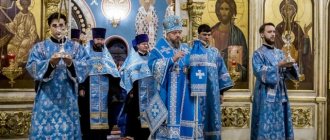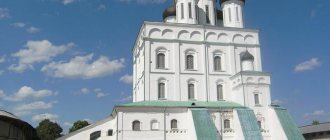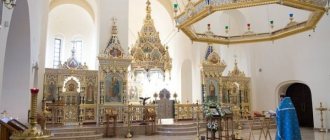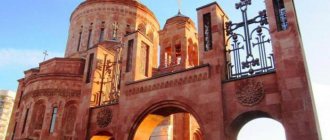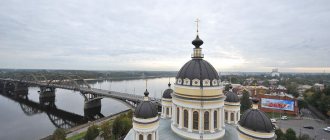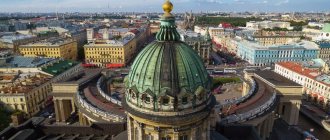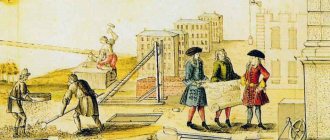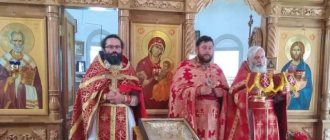In the photo: Znamensky Cathedral in 1968.
Over the first hundred years of its existence, counting from the date of the consecration of the main altar, the Znamensky Cathedral of Tyumen has changed beyond recognition, eventually turning from a fairly simple and traditional temple-“ship” into a complex structure that amazes us today with its bizarre forms.
Throughout the 19th century, the Znamensky Church lived a leisurely parish life. With the exception of natural disasters, during one of which - the cholera epidemic of 1848 - the miraculous icon of the Mother of God "The Sign" was found, the "external" life of the church was reduced to a series of renovations and reconstructions.
In 1904, a northern aisle was added to the Znamensky Church, and an octagonal light drum covered with a dome was placed above the refectory - all this, coupled with the bell tower “grown” by one tier, completely transformed the Znamensky Church. It is in this form that it appears to our eyes today, somewhat even lost from the elegant “abundance” and dynamism of its forms, flowing into one another.
The church has not been spared technical innovations either. The Znamensky Church was illuminated by electricity, and electric lighting was installed not only inside the church, but also outside. In 1913 it ceased to be a parish church, receiving the high status of a cathedral.
Meanwhile, prosperous times were coming to an end - a revolution broke out, burying the Russian Empire. The Znamensky Cathedral was perhaps lucky (relatively, of course!) - it was not destroyed either in the hysterical 1930s or during the Khrushchev persecution of religion, and it did not play a role unusual for an Orthodox church for too long.
The cathedral did not escape robbery during the so-called “seizure of church valuables” in 1922, and the robbers distinguished themselves with a special predilection for Jesuit techniques. When the believers proposed to the commission, which was going to “confiscate” the robe from the miraculous icon of the Mother of God “The Sign”, to replace it with an equal amount of silver and jewelry, it agreed, but a month later the representatives of the commission came for the robe itself, thereby profiting from the “religious people” in double size.
And then the Znamensky Cathedral was handed over to the renovationists, and in 1929 they set up a dormitory for collective farm cadets in it. In September 1941, the church building was converted for military purposes - military personnel lived in the main building, and a garage was installed in the disfigured southern aisle. Finally, in 1945 - on the wave of warming relations between the authorities and the Church - the Znamensky Cathedral was returned to the believers, and forever.
In May 1948, the Znamensky Cathedral received the status of a protected architectural monument.
Holy image of the “Sign” of the Mother of God
As mentioned above, there are many holy images in the church. The main holy image in the Cathedral is the face of Our Lady of the Sign. This image worked real miracles. The first miracle was associated with a cholera outbreak that occurred in 1848.
Must read: Raifa Mother of God Monastery
It was then that one of the parishioners of the church had a dream in which he saw the miraculous icon of the “Sign” of the Mother of God. In a dream, he dreamed that if he removed the face from the bell tower and took it around the city, the outbreak of the disease would disappear. A parishioner who saw this dream came to the Cathedral and retold it to other believers.
They decided to make the dream come true and took the image from the bell tower and took it on a hike around the city, while they went into houses where people living with this disease lived. A few days later, the epidemic of the disease began to gradually subside, and people who were sick with cholera began to recover.
This miraculous phenomenon aroused real strong faith in the souls of the parishioners. Since then, the holy face remained in the temple premises.
Znamensky Cathedral
Common names:
Cathedral of the Icon of the Mother of God “The Sign”
Located at:
Tyumen, st. Semakova, 13.
Date of creation:
XVIII century.
Virtual tour
Historical reference
The exact date of the founding of the church in honor of the Icon of the Mother of God “The Sign,” unfortunately, remains unknown; it ranges between 1624 and 1659. The first wooden church burned down in a fire in 1697, then was restored and again destroyed by fire in 1766. In 1768, at the expense of parishioners, a stone church was founded on the site of a burnt wooden one. The main stages of construction were completed in 1786.
During the 19th century, the building was repeatedly repaired and expanded with chapels through the efforts of merchant donors.
The church acquired its current appearance as a result of a radical reconstruction in 1901-1906, undertaken after a fire that destroyed one of the chapels.
Now the Znamensky Cathedral is a complex, but integral structure, a very interesting and rare example of Russian Baroque in Siberia.
In 1913, a celebration took place in the temple on the occasion of the renaming of the Znamenskaya Church from a parish to a cathedral. In 1929, the Znamensky Cathedral was closed. From 1930 to 1944, the cathedral building was used as a transit prison, and then as a MTS.
Once again, the church was returned to the believers on October 9, 1945, in accordance with Council of People’s Commissar Resolution No. 1325 of November 28, 1943, “On the procedure for opening churches.”
In May 1948, the Znamensky Cathedral received the status of a protected architectural monument.
On June 19, 1994, a religious procession was held in the cathedral for the first time in many years.
In 2003, the cathedral's domes and crosses were replaced using donations from parishioners.
Description
One of the best works of Russian baroque architecture in Siberia. The external ornament of the temple, its multi-tiered structure, the presence of several domes of different sizes, the bright blue and white shades of the walls and a number of other advantages give the architectural monument of the 18th century a particularly unique look.
The interior of the church is dominated by an extensive four-pillar refectory, open into chapels. On its western side there are choirs. Their design retains massive wooden carved consoles with volute-shaped elements and wooden sheathing of handrails with a geometric pattern.
The stone fence around the church, despite the stylistic divergence from the temple, is an important component of the ensemble. Two gates connect the site with city streets.
Orthodox activities of the Tyumen Cathedral
The main task of Orthodoxy is to bring spiritual revival to the masses, strengthen the Christian faith among the population, and acquire as many churchgoers as possible.
The Sunday school, which began its work in 1991, currently has more than two hundred children who regularly study the basics of Orthodoxy, the Law of God, study the basics of singing, and based on the lives of saints, learn to apply God’s commandments in life.
Thriving in temple studios:
fine arts; choral singing; handicrafts; modeling; photography.
Divine service in the Znamensky Cathedral
Not a single citywide event takes place without Sunday school representatives. Thanks to the work of the priests of the Cathedral of the Sign in Tyumen, the public life of the city is closely connected with the spiritual.
Links[ | ]
- City of Tyumen. Znamensky Cathedral (Russian). Tobolsk-Tyumen diocese. Access date: April 14, 2012.
- Cathedral of the Sign of the Blessed Virgin Mary. (Russian). Donskoy Monastery. Access date: April 14, 2012. Archived May 16, 2012.
- Znamensky Cathedral on Wikimapia
| Orthodoxy in Tyumen | |
| |
Soviet period
It can be assumed that with the advent of Soviet power, like most Orthodox churches, the Znamensky Cathedral in Tyumen had to cease its activities. But, despite the persecution, services were held in the temple until 1929. It was this year that the cathedral was closed, and its building was transferred to a sports club. Later it was used as a prison and as a machine and tractor station.
It is interesting that in 1933 the believers of the city and region managed to achieve the resumption of church services. And despite the fact that during the Second World War the church was closed again, after the end of hostilities the temple was finally returned to the fold of the Orthodox Church. This saved the ancient building from destruction.
In 2003, crosses and domes were replaced with donations from parishioners. Today, the Znamensky Cathedral in Tyumen, a photo of which we posted in this material, is a major center of the spiritual life of the city and the Tyumen region. The cathedral complex hosts craft clubs and a Sunday school.
Shrines
- revered copy of the miraculous Tyumen icon of the Mother of God “The Sign”
At the end of the 19th century, the temple housed
:
- eight-pointed silver cross under gold on a cypress tree, with holy relics: martyr. Theodore Stratelates, St. martyr like in Sevastia, martyr. Jacob the Persian, martyr. John's ilk in Belgrade, St. martyr like in Kizitsa, martyr. Eustratia, martyr. John the New, martyr. John, the king martyred by Diocletian. On the front side of the cross there was an inscription: “ This life-giving cross of the Lord was built for the Church of Our Most Holy Lady Theotokos of Her Honorable and Glorious Sign and the Holy Glorious Apostle and Evangelist John the Theologian, like the saints of our father John Chrysostom, Patriarch of Tsarygrad;
in Tyumen in the summer of 7167 [1659]
under the rightful sovereign Tsar and Grand Duke Alexei Mikhailovich of all great and small and white Russia, autocrat, and under Archbishop Simeon of Siberia and Tobolsk
"
Antiquities not related to church services:
- a silver ladle under gold, ancient hammered work, in the shape of a swan, with an inscription in Church Slavonic letters around it: “ The ladle of man’s goodness, drink from it for health, praying to God for the Sovereign
” - a silver ladle under gold, chased work, with an inscription all around: “ Drink the first glass for health, the second for satiety, the third for joy
”
History of the cathedral
Looking at the cathedral building, many will find it difficult to believe that it is almost 150 years old. But in reality this is true. Unfortunately, no one knows the exact date of construction of the church, but according to the data mentioned in history, it was around 1659.
The first temple stood for about 40 years. The first test was sent to him in the form of a fire. The temple burned down and in 1768 a plan for its reconstruction was specially developed and work began on the construction of a stone church. Along with the construction work, a garden was planted.
Later two more chapels were added. Three years later, construction work on the bell tower was completed. Today the Cathedral is a very beautiful building of complex shape. It hosts daily services.
It should also be noted that crusades in this temple have resumed since 1994. The largest Sunday school in Tyumen operates under him. Today there are more than 190 children aged 4 years and older studying there. The school provides lessons on studying the Law of God, church singing and the lives of saints. The educational institution also hosts various clubs on handicrafts, photography and much more.
Dear brothers and sisters! We invite you to visit the unique resource https://www.slovo-pomoshi.ru/. With its help, you can convey your aspirations to St. Petersburg churches, chapels, monasteries, and also contact the righteous at the place of their burial. We will write a note ourselves, take it to the temple and send you a photo report by email. Turning to God with the help of prayers has helped many people overcome grief, regain health and the joy of worldly life.
Useful articles:
The other day I consecrated an apartment in one house... I saw that the owners were well prepared: icons, cross stickers, candles, incense, oil... Stop. I look: there is some kind of red sediment and suspension in the oil. At first I even thought that this was oil from Unction. I'm starting to find out. They explain to me that, AS SUPPOSED (!), Tabasco sauce is added there!... Read more
REVEREND STILIAN - PATRON AND HEALER OF CHILDREN Have you ever seen such an interesting icon, which depicts a holy monk holding a baby in his arms? Yes, this icon is very rare, and few people know such a saint... but this is here, in Russia. And in Greece and Orthodox Cyprus everyone knows this saint and reveres him very much!!! P… Read more
Simply baptized Simply baptized is when icons hang in your car, but you smoke in the same car and say obscenities (a prayer to the devil) and blasphemy against the Lord! Simply baptized is when you visit the Temple of God only on Easter and Christmas. Simply baptized - this is when the essence of Easter concludes... Read more
A parable about why Death needs a scythe. Unexpected ending. -Are you a blacksmith? The voice behind him came so unexpectedly that Vasily even flinched. In addition, he did not hear the door to the workshop open and anyone come inside. —Have you tried knocking? - he answered rudely, slightly angry both at himself and at the nimble client... Read more
Clergy
According to diocesan directories for 1895 and 1897, the church had a priest and a psalm-reader on staff. On November 20, 1900, a vacancy for a deacon was opened [10]. There were wooden houses for the clergy, purchased in 1886 and owned by the church [9].
Abbots
- Jacob Slovtsov (November 18, 1837 - April 23, 1844)
- …
- Andrey Perov (1864 - October 1, 1882)
- Pyotr Rebrin (1882 - 1917?)
- Sschmch. Mikhail Makarov (1917 - 1918)
- Alexander Zamyatin (June 26, 1920 - August 1, 1921)
- Seraphim (Korovin) (1923 - 1924)
- Valery Gordeev (mentioned April 1992 - mentioned 1999)
since 1990 - Eminences of Tobolsk
Information for guests and pilgrims
The Tyumen Cathedral is open daily, on weekdays the morning liturgy begins at 8.30, on Sunday you can attend two liturgies, which respectively begin at 6.30 and 9.00.
Evening services always begin at 17.00. If desired, you can order a prayer service, which will be read on Monday - Thursday at 14.00.
The address of the Cathedral "Znamenie" Tyumen, Semakova street, building 13. All questions about services, confession, communion and custom prayers can be clarified by phone.
Znamensky Cathedral in Tyumen
Similar articles
Assumption Cathedral in PenzaZnamensky Cathedral in KemerovoEpiphany Cathedral in ElokhovVoznesensky Cathedral in Novosibirsk
Znamensky Cathedral reviews
Ivan
September 26, 2021 at 5:28 am
The parish of this Temple is quite large and consists of very church-going people. In the Temple there are such Icons that cannot be found in the whole world. Many of them are miraculous. Just look at the Icon of Metropolitan John of Tobolsk, which was previously practically closed to parishioners and was located on the right side of the Royal Doors. Now she meets people on the first left column from the entrance. She has already brought many people back to the Bosom of the Church. And it gives such healing (including the mind and heart) as does the Icon of Panteleimon the Healer on the right column, the first from the entrance, where the valiant warrior of Christ’s Shepherd and healer of our souls and bodies appears with a very merciful face and a gaze that pierces the soul. One of the recent icons that appeared in the Temple - the Most Holy Theotokos - resolves the conflict with the Roman Catholic Church (subjectively) for all those who mourn and with its face resembles the Virgin Mary of Guadalupe, and also gives strength not to lose heart from many sorrows. But the Icon of the Mother of God of the Sign with two Angels Gabriel and Seraphim, which more than once saved the city and the surrounding area from cholera, is more famous. According to Wikipedia: <<Since August 8, 1848, the Mother of God was celebrated in the church for the deliverance of the townspeople from cholera>>. This Temple suffered a lot after 1917 and many Icons were lost and the utensils (including Precious ones) were taken away by the Soviet government. An unchurched person or a Muslim will say: what kind of idolatry of Icons is this. To which I will say that they give an understanding of certain higher ideals, with which it is worth comparing your burdened soul, vegetated in the vanity of the world. But I won’t argue, because people come to Church not because of the Icons, but because of catharsis. And even more - behind the Providence of the Lord. This Temple is served by Archpriest Fr. Nikolay, to whom people come for advice from all the surrounding areas, but they know about him far beyond the borders of Tyumen. For Confession alone, he gathers a flock of more than 50 people, and maybe much more, because the line stretches from the very entrance to the Temple. It is worth contacting him especially for family people. Well, the more ascetic white monks (this includes Fr. Valery and Fr. Aleksky) can in time (using their example) return a lost soul to the Bosom of the Church. And of course, one of the most important Temples in the city is rectored by Metropolitan Dimitri himself, who can be found in the Temple during great services and holidays. Be sure to come to the Temple for a fresh breath of air and the Blessing, which are so lacking in the bustle of the city; besides, the Znamensky Cathedral is located in the very center of the city, on Semakova, 13. The Temple choir deserves special thanks! When you listen to him, you get the impression that the doors to the Kingdom of Heaven have opened slightly for you, a sinner, and a tear involuntarily flows from your eye. Thank you very much to the Cossacks for your vigilance against suspicious persons and for regulating people in the Temple in order to avoid crowds on holidays! Also on major holidays, police and traffic police are on duty.
How to get there?
We told you about the history of the Znamensky Cathedral of Tyumen, whose address is: st. Semakova, 13. Today it is visited by numerous pilgrims from different regions of our country who want to pray at the miraculous images of the temple. Tyumen is a modern, dynamically developing city, so it will not be difficult to get to it from other Russian regions. Airplanes fly to this northern city; the main railway route to the east, the Trans-Siberian, passes through Tyumen. Motorists can get to the city via highways R-254 (from Kurgan), R-351 (from Yekaterinburg), R-402 (from Omsk).
The Znamensky Cathedral of Tyumen is located in the city center, on the street. Semakova, 13. There are several public transport stops nearby. From the railway station you will be taken here by buses No. 13, 20, 34 or minibus No. 34.
Sources:
- https://posmotrim.by/article/znamenskij-sobor-tyumen.html
- https://ikona-i-molitva.info/znamenskij-kafedralnyj-sobor-tyumen/
- https://molitva-info.ru/tserkvi-i-hramy/znamenskij-kafedralnyj-sobor-v-tyumeni.html
- https://fb.ru/article/385484/znamenskiy-kafedralnyiy-sobor-tyumen-foto-istoriya-adres-kak-dobratsya
Literature
- Tobolsk diocesan address-calendar for 1895, p. 166.
- Tobolsk diocesan address-calendar for 1897. Section three. Information about churches, clergy and parishes, p. 70-71.
- Church of the Sign of the Blessed Virgin Mary in the city of Tyumen
// Tobolsk Diocesan Gazette, 1898, No. 19, unofficial department, p. 458 - 467. - Journal of the Council of the Tobolsk Diocesan Orthodox Church Brotherhood.
September 6/16, 1899. No. 23 // Tobolsk Diocesan Gazette, 1899, No. 19, unofficial department, p. 269, 272, 275, 286. - Rebrin Peter, priest. Consecration of the Tyumen Church of the Sign
// “Tobolsk Diocesan Gazette”, 1901, No. 20, unofficial department, p. 476-480. - Tobolsk diocesan address-calendar for 1903. Information about churches and parishes, p. 10.
